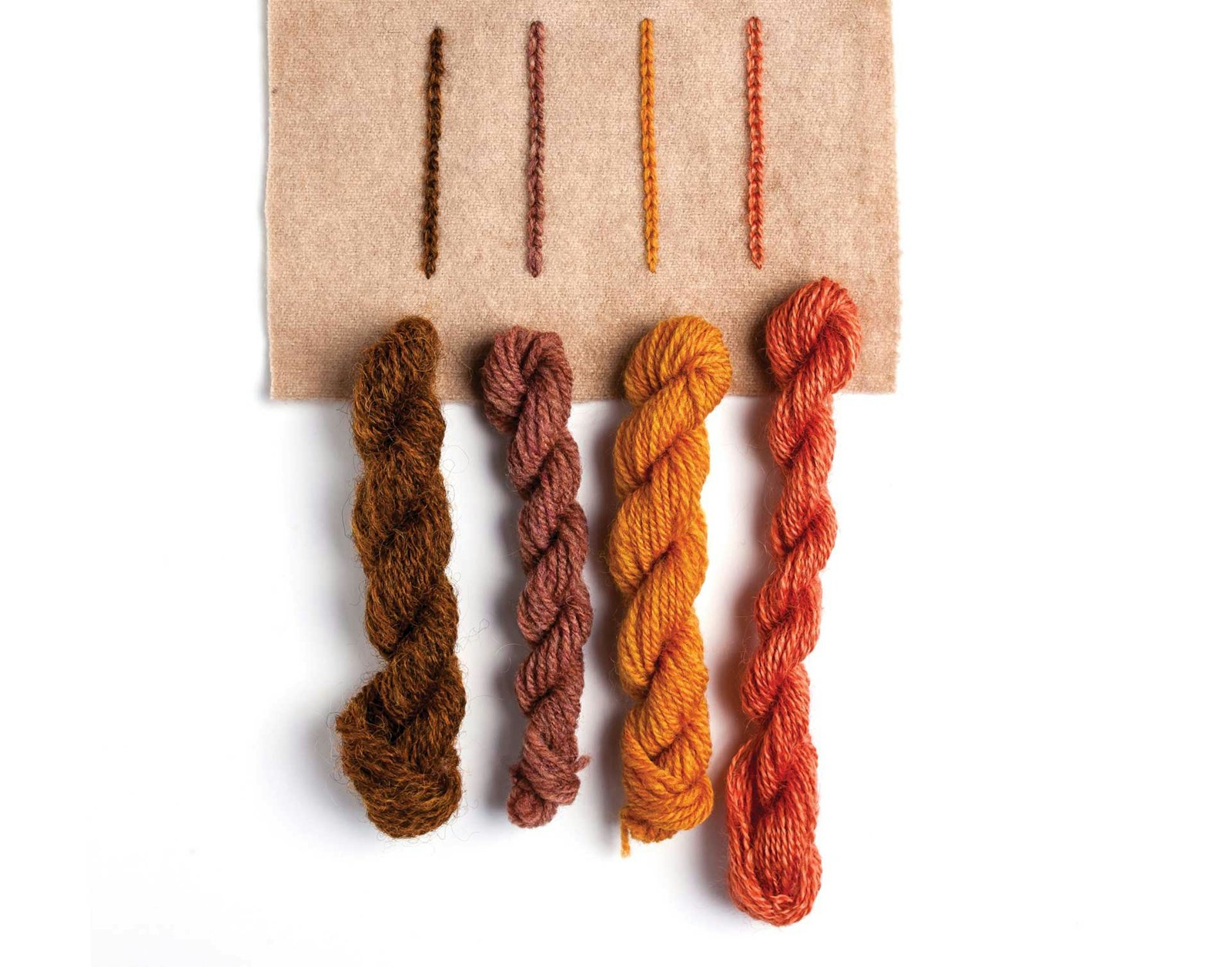Embroidery using woolen yarns, often called crewel embroidery. These five common stitches are some of my favorites for embroidering with handspun yarns. To learn more about spinning woolen embroidery yarns, read "Sublime Stitches Part 1: Spinning Wool for Embroidery."
Embroidery Hints
Many types of ground materials (base fabrics) work well for embroidery. Much of my work is done using recycled woolen fabrics I find at thrift stores. I love incorporating the character of fabrics that have had a previous life into my work. I often use the legs of woolen trousers to make small embroidered bags. Whether you are using new or recycled ground fabric, wash it first to allow for shrinkage before embroidering.
Dissolvable film such as Super Solvy makes it easy to transfer the motif onto many surfaces and colors. Simply trace your motif onto the clear film, baste onto the ground surface, embroider, and then place the piece in water to dissolve the film. The thin layer of film also makes it easier to embroider knitted or loosely woven cloth by creating a smooth work surface.
Using yarn that is too large for the chosen motif can make embroidery difficult and give it a squished appearance. Learning what you like and don’t like comes with time—practice will be your best guide. If the motif is too small for the yarn you would like to use, try eliminating some of the elements or enlarging the motif.
ADVERTISEMENT
The following instructions assume the yarn and needle are beginning on the wrong side of the fabric. For additional information on stitches, techniques, and tools, see Resources.
Buttonhole Stitch
This stitch creates a toothed edge that can be worked inside other motifs or as an outside edge.

Buttonhole Stitch
To make a stitch: Needle comes up through fabric along the line connecting the row of teeth. Stitches are formed by inserting needle at the top of the next tooth and back to the RS at the base of the tooth, keeping the working yarn below the row of stitches.
Chain Stitch
Chain stitch can be used to create thick lines and shaped edges or to fill in large areas with dense stitches. Use chain stitch instead of satin stitch or couching to add extra durability.

Chain Stitch
To make a stitch: Needle is inserted up through the fabric where the chain is to begin. Reinsert needle into the same hole, creating a loop on RS. Needle tip comes back to RS one stitch length ahead, catching loop.
Couching
Yarns that are too large, too rigid, or too precious to be embroidered using stitches that pass through the fabric and appear on the back of the work can be couched. Couching has many variations but is a process that involves two yarns: one that lies on the surface, and another yarn that sews the first yarn in place. Yarns and threads used to hold the main yarn in place can be hidden or sharply contrasted to add further design to the piece—it’s up to you!

Couching
To make a stitch: Lay the yarn to be couched (primary yarn) on the fabric surface. If desired, about an inch of the beginning end can be pulled through the ground with a sharp darning needle and secured on WS. Insert needle with secondary yarn close to the primary yarn and bring to RS. Reinsert needle into fabric on the other side of the primary yarn to create a stitch, couching the primary yarn. Repeat along the length of the primary yarn. Finish by securing the end of the primary yarn as for the beginning if desired.
Satin Stitch
This stitch is used to create solid areas of color. It works well with round, soft yarns.

Satin Stitch
To make a stitch: Needle is inserted, coming to RS on one edge of the motif, and is reinserted on the other side of the motif, creating a long stitch that lies on the surface of the work.
Stem Stitch
Stem stitch makes a fine, tidy line that is perfect for outlining motifs.

Stem Stitch
To make a stitch: Bring needle up to RS where the line of stitches will begin. Needle is inserted down into the cloth a stitch length ahead and comes back up next to the previous stitch.
Resources
- Gravjord, Ingebørg. Votten i Norsk Tradisjon. Oslo: Landbruksforlaget, 1986.
- Paine, Sheila. Embroidered Textiles. London: Thames and Hudson, 2008.
- Shaughnessy, Katherine. The New Crewel: Exquisite Designs in Contemporary Embroidery. New York: Lark Crafts, 2005.

